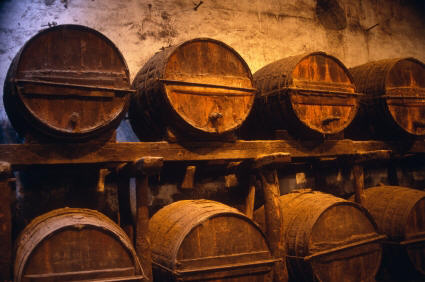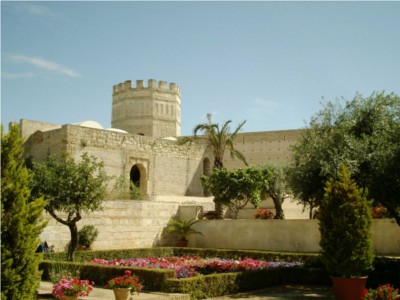 Jerez de la Frontera must be one of the most undiscovered tourist attractions in Andalucia. This may be due to its position, almost midway between the famous cities of Cadiz and Seville, or just an accident. It may be that its charms are difficult to find because signposting of its hotels and attractions within the city is, to be kind, poor. None of that matters because the local populace are not only very friendly the majority also speak excellent English due to the influx of English partners and staff into the booming sherry industry over the last two hundred years.
Jerez de la Frontera must be one of the most undiscovered tourist attractions in Andalucia. This may be due to its position, almost midway between the famous cities of Cadiz and Seville, or just an accident. It may be that its charms are difficult to find because signposting of its hotels and attractions within the city is, to be kind, poor. None of that matters because the local populace are not only very friendly the majority also speak excellent English due to the influx of English partners and staff into the booming sherry industry over the last two hundred years.
A tour of a bodega is almost mandatory in Jerez but for those prepared to look, there is lots more to see. You will inevitably arrive in Plaza del Arenal, the main square in the town. In the centre is a sculpture of General Miguel Primo de Rivera mounted on a horse. Rivera was born in Jerez and became dictator of Spain between 1923 and 1930.
Just outside Plaza del Arenal and to the south is the Alcazar. This was built in the 12th century and is one of the few examples of Almohade architecture in Spain. Remaining from that period are two gates, a small mosque, an octagonal tower, the baths, the Palace of Dona Blanca and the Villavicencia Palace. The Alcazar dates back to the 12th century with some more modern additions, the homage tower was built in the 15th century and the oil mill in the 18th. The most attractive part of the Alcazar has to be the gardens, laid out in typical symmetrical Arabic style, with an enormous sculpture of three horses and a number of small fountains.
 The whole has been well preserved. As you enter the Alcazar through the city gate, the mosque is to your left. Whilst not being as large or elaborate as the mesquite in Cordoba it has a simple charm more fitting to its purpose. In the Villavicencia Palace, on the ground floor, is a relief model of Xerez as it was in the 12th century after the Alcazar was built. It is only when you see this model that you realize how extensive the city was at that time. At the time of writing the Palace of Dona Blanca together with the Octagonal Tower and Homage Tower were closed for renovation.
The whole has been well preserved. As you enter the Alcazar through the city gate, the mosque is to your left. Whilst not being as large or elaborate as the mesquite in Cordoba it has a simple charm more fitting to its purpose. In the Villavicencia Palace, on the ground floor, is a relief model of Xerez as it was in the 12th century after the Alcazar was built. It is only when you see this model that you realize how extensive the city was at that time. At the time of writing the Palace of Dona Blanca together with the Octagonal Tower and Homage Tower were closed for renovation.
You will find more horses in Plaza del Caballo, a giant sculpture of two bronze horses, and yet more in Plaza Mamelon. There you will see a monumental bronze of a carriage being drawn by five horses with an outrider. It is the work of Eduardo Soriano. It is no wonder that horses feature strongly for Jerez's second industry is training them. The Royal Andalusian School of Equestrian Art Foundation is based at Jerez. Their famously choreographed performance, 'How the Andalucian Horses Dance' is famous throughout Spain. Visitors can see a show and tour the school that includes the training sessions, the stables, the Palace rooms, the Museum of Equestrian Arts and the Carriage Museum. Details of the times of shows, opening times of the museum and Palace and prices vary so contact 956 319 635 before your visit. The first week of May is the time of the Feria del Caballo when these beautifully groomed horses parade around the city and the school organise gala performances on Fridays and Saturdays. The fair in 2010 is from the 2nd to the 9th May.
In nearby Calle Cervantes, if you have time, visit the clock museum. On the hour, every hour all the 302 clocks variously ring, chime, ding and dong. On the quarter hour only the English clocks chime, deep Westminster chimes predominate, and on the half hour it is the turn of the French clocks, lighter tinkles and trings in the background. The majority of the displays are unique pieces from the 17th, 18th and 19th centuries, each spotlighted in beautiful mahogany cases and each wound conscientiously every week by the sole employed clockmaker. The clock museum houses the largest collection of working clocks from this period in the world.
You will see the striking contrast between the French clocks and the English. The French were much more concerned with the decorative aspect of their clocks rather than the mechanism whilst the English clocks are less decorative but have more accurate timekeeping. The debate during the 16th century was whether or not a long pendulum produced more accurate time. Only later science in the 17th century proved that the length of the pendulum was important.
You will also see some unusual clocks including a portable English sundial clock. Portable sundials had been used for timekeeping since at least the 12th century. Later versions were aligned north/south using an integral compass. The gun clock also utilised a sundial. This was a more permanent structure. At noon the sun's rays were focused using a magnifying glass on the touchhole of a small cannon. This ignited the gunpowder and discharged the cannon, brilliant.
 The clock museum is open 10am to 3pm Tuesday to Sunday and at various times in the evening depending on the month.
The clock museum is open 10am to 3pm Tuesday to Sunday and at various times in the evening depending on the month.
The Municipal Archaeoligical Museum in Plaza del Mercado is well worth a visit if is open. At the time of writing (December 2009) the museum had been closed for four years with no sign of it reopening. This museum contains a 1st millennium BC Greek helmet that was dredged out of the Rio Guadalete. It is believed to be the oldest Greek object found in Spain.
The population of Jerez obviously enjoy their food and sitting out of an evening. There are any number of cafes and bars, most of which serve tapas. You will find many local dishes such as kidneys cooked in sherry, lamb cutlets in oregano and sherry and fish in a tomato and brandy sauce; you would be excused for thinking that water is a rare commodity in Jerez cuisine. The dishes are delicious. A visit to the thriving indoor market illustrates why. This is very obviously the place where the majority of people buy their fresh meat, fish and vegetables. There is a huge fresh fish market with over fifty stalls selling fish from the auction at Puerto de Santa Maria, everything from giant tuna to bocarones and shellfish from huge spider crabs to diminutive Cadiz Bay shrimps, the latter piled in boxes and so fresh they are still leaping into the air trying to get back to the sea.
There is a similar sized vegetable market. It is packed every day with customers competing for the best buys. There is every seasonal vegetable imaginable, much of it from Conil and Chiclana. The smaller meat market is an equal revelation with the usual beef, lamb and pork, enhanced with game in season, partridges, pheasants and rabbit from the campo.
On the subject of shopping. It is clear that out of town shopping in Jerez has not really taken off. The centre of the town is full of pedestrian streets with busy big name stores in between small bodegas where you can partake of the sherries and brandies from all the bodegas in town if you so wish. Shops observe the siesta so open in the evenings until 8pm or later. Restaurants and cafes open for dinner at any time after that.